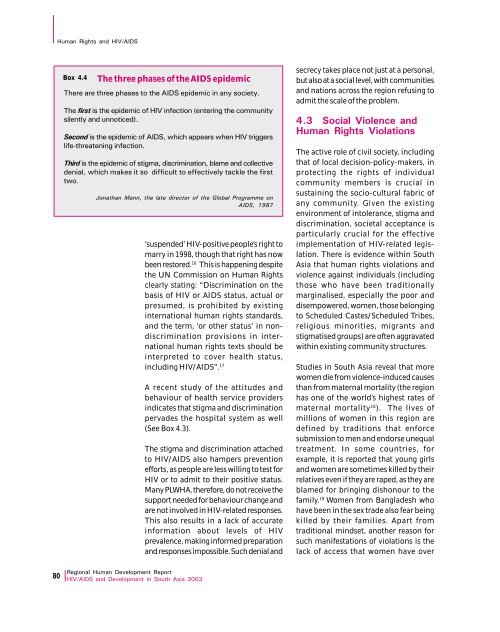Download Report - UNDP Asia-Pacific Regional Centre - United ...
Download Report - UNDP Asia-Pacific Regional Centre - United ...
Download Report - UNDP Asia-Pacific Regional Centre - United ...
Create successful ePaper yourself
Turn your PDF publications into a flip-book with our unique Google optimized e-Paper software.
Human Rights and HIV/AIDSBox 4.4The three phases of the AIDS epidemicThere are three phases to the AIDS epidemic in any society.The first is the epidemic of HIV infection (entering the communitysilently and unnoticed).Second is the epidemic of AIDS, which appears when HIV triggerslife-threatening infection.Third is the epidemic of stigma, discrimination, blame and collectivedenial, which makes it so difficult to effectively tackle the firsttwo.Jonathan Mann, the late director of the Global Programme onAIDS, 1987‘suspended’ HIV-positive people’s right tomarry in 1998, though that right has nowbeen restored. 16 This is happening despitethe UN Commission on Human Rightsclearly stating: “Discrimination on thebasis of HIV or AIDS status, actual orpresumed, is prohibited by existinginternational human rights standards,and the term, ‘or other status’ in nondiscriminationprovisions in internationalhuman rights texts should beinterpreted to cover health status,including HIV/AIDS”. 17A recent study of the attitudes andbehaviour of health service providersindicates that stigma and discriminationpervades the hospital system as well(See Box 4.3).The stigma and discrimination attachedto HIV/AIDS also hampers preventionefforts, as people are less willing to test forHIV or to admit to their positive status.Many PLWHA, therefore, do not receive thesupport needed for behaviour change andare not involved in HIV-related responses.This also results in a lack of accurateinformation about levels of HIVprevalence, making informed preparationand responses impossible. Such denial andsecrecy takes place not just at a personal,but also at a social level, with communitiesand nations across the region refusing toadmit the scale of the problem.4.3 Social Violence andHuman Rights ViolationsThe active role of civil society, includingthat of local decision-policy-makers, inprotecting the rights of individualcommunity members is crucial insustaining the socio-cultural fabric ofany community. Given the existingenvironment of intolerance, stigma anddiscrimination, societal acceptance isparticularly crucial for the effectiveimplementation of HIV-related legislation.There is evidence within South<strong>Asia</strong> that human rights violations andviolence against individuals (includingthose who have been traditionallymarginalised, especially the poor anddisempowered, women, those belongingto Scheduled Castes/Scheduled Tribes,religious minorities, migrants andstigmatised groups) are often aggravatedwithin existing community structures.Studies in South <strong>Asia</strong> reveal that morewomen die from violence-induced causesthan from maternal mortality (the regionhas one of the world’s highest rates ofmaternal mortality 18 ). The lives ofmillions of women in this region aredefined by traditions that enforcesubmission to men and endorse unequaltreatment. In some countries, forexample, it is reported that young girlsand women are sometimes killed by theirrelatives even if they are raped, as they areblamed for bringing dishonour to thefamily. 19 Women from Bangladesh whohave been in the sex trade also fear beingkilled by their families. Apart fromtraditional mindset, another reason forsuch manifestations of violations is thelack of access that women have over80<strong>Regional</strong> Human Development <strong>Report</strong>HIV/AIDS and Development in South <strong>Asia</strong> 2003
















